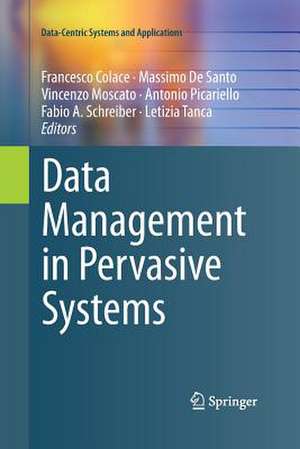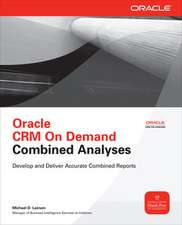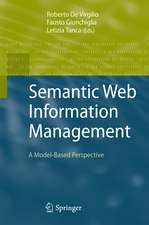Data Management in Pervasive Systems: Data-Centric Systems and Applications
Editat de Francesco Colace, Massimo De Santo, Vincenzo Moscato, Antonio Picariello, Fabio A. Schreiber, Letizia Tancaen Limba Engleză Paperback – 23 aug 2016
| Toate formatele și edițiile | Preț | Express |
|---|---|---|
| Paperback (1) | 337.00 lei 43-57 zile | |
| Springer International Publishing – 23 aug 2016 | 337.00 lei 43-57 zile | |
| Hardback (1) | 333.50 lei 38-44 zile | |
| Springer International Publishing – 24 oct 2015 | 333.50 lei 38-44 zile |
Din seria Data-Centric Systems and Applications
- 20%
 Preț: 777.06 lei
Preț: 777.06 lei - 20%
 Preț: 430.26 lei
Preț: 430.26 lei - 20%
 Preț: 340.32 lei
Preț: 340.32 lei - 20%
 Preț: 337.91 lei
Preț: 337.91 lei - 20%
 Preț: 499.23 lei
Preț: 499.23 lei - 20%
 Preț: 1062.89 lei
Preț: 1062.89 lei - 20%
 Preț: 344.76 lei
Preț: 344.76 lei - 20%
 Preț: 663.61 lei
Preț: 663.61 lei - 20%
 Preț: 607.51 lei
Preț: 607.51 lei - 20%
 Preț: 347.74 lei
Preț: 347.74 lei - 20%
 Preț: 512.72 lei
Preț: 512.72 lei - 20%
 Preț: 339.14 lei
Preț: 339.14 lei - 20%
 Preț: 698.57 lei
Preț: 698.57 lei - 20%
 Preț: 650.27 lei
Preț: 650.27 lei - 20%
 Preț: 375.69 lei
Preț: 375.69 lei - 20%
 Preț: 420.84 lei
Preț: 420.84 lei - 20%
 Preț: 479.30 lei
Preț: 479.30 lei - 20%
 Preț: 321.70 lei
Preț: 321.70 lei - 20%
 Preț: 726.16 lei
Preț: 726.16 lei - 20%
 Preț: 333.50 lei
Preț: 333.50 lei - 20%
 Preț: 834.36 lei
Preț: 834.36 lei - 20%
 Preț: 333.88 lei
Preț: 333.88 lei - 20%
 Preț: 520.82 lei
Preț: 520.82 lei
Preț: 337.00 lei
Preț vechi: 421.25 lei
-20% Nou
Puncte Express: 506
Preț estimativ în valută:
64.48€ • 67.51$ • 53.36£
64.48€ • 67.51$ • 53.36£
Carte tipărită la comandă
Livrare economică 07-21 aprilie
Preluare comenzi: 021 569.72.76
Specificații
ISBN-13: 9783319372655
ISBN-10: 3319372653
Pagini: 366
Ilustrații: XXII, 366 p.
Dimensiuni: 155 x 235 mm
Greutate: 0.54 kg
Ediția:Softcover reprint of the original 1st ed. 2015
Editura: Springer International Publishing
Colecția Springer
Seria Data-Centric Systems and Applications
Locul publicării:Cham, Switzerland
ISBN-10: 3319372653
Pagini: 366
Ilustrații: XXII, 366 p.
Dimensiuni: 155 x 235 mm
Greutate: 0.54 kg
Ediția:Softcover reprint of the original 1st ed. 2015
Editura: Springer International Publishing
Colecția Springer
Seria Data-Centric Systems and Applications
Locul publicării:Cham, Switzerland
Cuprins
Part I Preliminaries and relevant related topics.- 1 The Internet of Things and value co-creation in a Service Dominant logic perspective.- 2 Pervasive Systems Architecture and the main related technologies.- 3 Privacy in Pervasive Systems: Social and Legal Aspects and Technical Solutions.- Part II Sensors, data streams and storage.- 4 Sensors and Wireless Sensor Networks as data sources: models and languages.- 5 Data Streams and Data Stream Management Systems and Languages.- 6 The Complex Event Processing Paradigm.- 7 Applying Semantic Interoperability Principles to Data Stream Management.- Part III Social networks as information sources.- 8 Multimedia Social Networks for Cultural Heritage Applications: the GIVAS project.- 9 Sentiment Detection in Social Networks using semantic analysis: a tool for sentiment analysis and its application in Cultural Heritage realm.- 10 Security and Privacy Issues in Social Networks.- Part IV Context awareness and personalization.- 11 Data Personalization.- 12 Context Awareness in Pervasive Information Management.- 13 Context Awareness in Mobile Systems.- Part V Multimedia information management.- 14 Content-Based Multimedia Retrieval.- 15 Multimedia Queries in Digital Libraries.- 16 Multimedia Recommendation and Delivery strategies.- Part VI Application to the DATABENC case study.- 17 PATCH: a Portable context-aware Atlas for browsing Cultural Heritage.
Textul de pe ultima copertă
The goal of this book is to provide a systematic description of the various research issues related to the management of information in pervasive systems, illustrating the state of the art in this area. Accordingly, it both outlines the foundations and basic technologies and presents more advanced aspects, making it suitable for self-contained graduate courses or seminars on pervasive data management or distributed systems.
The book is organized into six parts, including an illustrating case study. Part 1 briefly covers the basic ideas underlying the economic, technological, social and legal aspects of pervasive systems. Part 2 then describes several aspects of sensor networks and data stream processing, while part 3 highlights the main aspects of social networks with a special emphasis on cultural heritage applications. Next, part 4 details personalization and context awareness issues in pervasive environments, and part 5 reports on multimedia aspects, again with a particular focus on cultural heritage. The overall picture of the technological challenges and opportunities are illustrated in part 6 with the support of a cultural heritage case study, the DATABENC1 project on Italy’s Campania region. Each part is accompanied by its own foreword.
Readers from two main categories will benefit most from this book: IT researchers and professionals will learn about the latest advances in pervasive technologies and at the same time familiarize themselves with specific issues concerning cultural heritage; while humanities and cultural heritage experts and enthusiasts will find an introduction to the enabling technologies that are so promising for their field of application.
The book is organized into six parts, including an illustrating case study. Part 1 briefly covers the basic ideas underlying the economic, technological, social and legal aspects of pervasive systems. Part 2 then describes several aspects of sensor networks and data stream processing, while part 3 highlights the main aspects of social networks with a special emphasis on cultural heritage applications. Next, part 4 details personalization and context awareness issues in pervasive environments, and part 5 reports on multimedia aspects, again with a particular focus on cultural heritage. The overall picture of the technological challenges and opportunities are illustrated in part 6 with the support of a cultural heritage case study, the DATABENC1 project on Italy’s Campania region. Each part is accompanied by its own foreword.
Readers from two main categories will benefit most from this book: IT researchers and professionals will learn about the latest advances in pervasive technologies and at the same time familiarize themselves with specific issues concerning cultural heritage; while humanities and cultural heritage experts and enthusiasts will find an introduction to the enabling technologies that are so promising for their field of application.
Caracteristici
Outlines the foundations and basic technologies and presents more advanced aspects of pervasive data management Provides an overall picture of the technological challenges and opportunities related to the management of information in pervasive systems, illustrated with the support of a large cultural heritage case study Appeals to researchers and professionals from computer science as well as to cultural heritage experts interested in promising enabling technologies Includes supplementary material: sn.pub/extras























